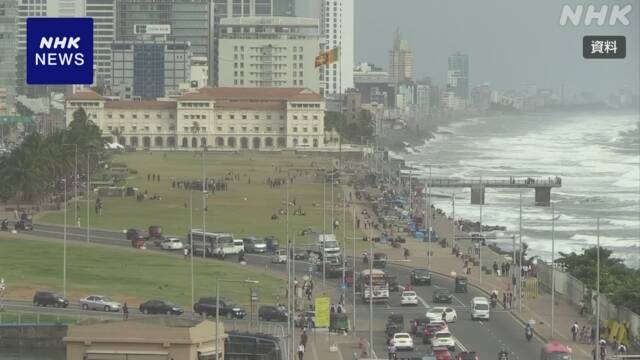【記事】IMF 経済危機のスリランカに約500億円融資へ 事務レベル合意 / NHK
2023.10.20
https://www3.nhk.or.jp/news/html/20231020/k10014231571000.html

IMF=国際通貨基金は、深刻な経済危機に陥っているスリランカに対して3億ドル余り、日本円でおよそ500億円の融資を行うことで事務レベルの合意に達したと発表しました。
IMFは、深刻な経済危機によって、中国などからの対外債務を支払えず事実上のデフォルトに陥ったスリランカを支援するため、ことし3月、4年間でおよそ30億ドルの融資枠を設定しました。
この融資は、財政再建など改革の進展を確認して実施されることになっていて、IMFは19日、3億3000万ドル、日本円にしておよそ500億円の融資を行うことで事務レベルの合意に達したと発表しました。
IMFは発表の中で「スリランカの改革は実を結び始めており、経済は安定化の兆しを見せている」と評価したうえで、改革の勢いを維持することが最も重要だと指摘しています。
スリランカの債務問題をめぐっては、巨額の債務負担を減らすため、債権国との交渉が鍵になっていて、スリランカ財務省は11日、中国の中国輸出入銀行とおよそ42億ドル、日本円にしておよそ6300億円の債務再編の条件などについて合意したと発表しました。
一方、債権国の日本、フランス、インドや金融機関など、民間の債権者との協議は続いていて、負担の軽減に向けた交渉で合意できるかが焦点となっています。

スリランカでは停電やガソリン不足、インフレなどは最悪期を脱したものの経済の立ち直りはまだまだ先のようです。IMFからの融資に絡んで、スリランカ国内では、法人税制がよりシビアになりました(苦笑)
普通に暮らす市民の生活は、なかなか楽になりませんね(政治家の長年の失策を放置して、今国民がそのツケを払っているようにも見えます)…


参考レート:1Rs=0.46 円(Rsを約半分にして円をつける)
【スリランカ債務整理関連 関連ニュース(2023年10月27日講義補足資料/北海道教育大学函館校)】
- 1. 2023.10.20
- 2. 【スリランカ債務整理関連 関連ニュース(2023年10月27日講義補足資料/北海道教育大学函館校)】
- 2.1. 2023年10月12日 スリランカ、中国と6300億円分の債務再編で合意-IMF資金確保に道 / ブルームバーグ
- 2.2. 2023年9月2日 経済危機のスリランカ 日本主導の債務再編を高く評価 大統領 / NHK
- 2.3. 2023年5月9日 スリランカ債務、早期圧縮一致 中国はオブザーバー参加 / 日本経済新聞
- 2.4. 2023年4月14日 スリランカ債務再編へ日印仏の新枠組発足、中所得国債務問題に「光」か / 第一生命経済研究所
- 2.5. 2023年4月12日 スリランカ債務再編、日本主導で新枠組み 中国対応焦点 / 日本経済新聞
- 2.6. 2022年9月6日 1からわかる!中国「一帯一路」【中】改訂版 起爆剤か?債務のワナか? / NHK
- 2.7. 2022年8月30日 1からわかる!中国「一帯一路」ってなに?【上】改訂版 / NHK
- 2.8. 2022年9月13日 1からわかる!中国「一帯一路」【下】構想が変容!?米中対立の根源に? 改訂版
- 2.9. 2023年2月 最近のスリランカ経済 / 在スリランカ日本国大使館
- 2.10. 2023年1月2日 Economic Crisis, Inflation and Poverty in Sri Lanka / London School of Economics and Political Science
- 2.11. 2023年6月8日 Sri Lanka’s population in poverty surges to 31-pct of population: LirneAsia Survey / Economy Next
- 2.12. 2022年12月貧困ライン統計値 Official poverty line by District : December 2022 / Department of Census & Statistics
2023年10月12日 スリランカ、中国と6300億円分の債務再編で合意-IMF資金確保に道 / ブルームバーグ
●長期的な債務の持続可能性や経済回復への重要な一歩-スリランカ
●日本やインドとの合意目指すスリランカ、中国と交わす条件も鍵に
スリランカと中国は42億ドル(約6300億円)分の債務再編で合意した。スリランカにとっては国際通貨基金(IMF)からの新たな資金確保に近づくことになる。
スリランカ財務省は11日遅くの声明で、「債務処理に関する主な原則や示唆的条件」を巡り中国側と合意に至ったと説明。長期的な債務の持続可能性や経済回復に向けた重要な一歩になると評価した。
声明によれば、スリランカ当局と中国輸出入銀行は向こう数週間で債務処理を正式化し、その実行に積極的に取り組む。合意の詳細については言及を控えた。
スリランカが日本やインドなど他の債権国や、外債保有者との合意に向けた取り組みを強化する中、今回の暫定合意は債務再編の完了に向けた後押しとなる。損失をどのように共有するのかを巡って当局者が詳細を詰める中、スリランカが中国と交わす条件は他の債権者との交渉にとっても鍵になる。
https://www.bloomberg.co.jp/news/articles/2023-10-12/S2EFYFDWLU6801
2023年9月2日 経済危機のスリランカ 日本主導の債務再編を高く評価 大統領 / NHK
経済危機で債務不履行に陥ったスリランカの大統領がNHKのインタビューに応じ、日本が主導して債務の再編を進めていることを高く評価しました。また、中国に運営権が譲渡され、「債務のわな」の典型例とされる南部の港については、「軍事的な管理はスリランカ側の手中にある」と述べ、安全保障とは別問題だと強調しました。
インド洋の島国、スリランカは財政政策の失敗などで急激な通貨安やインフレに見舞われ、去年4月には対外的な債務の支払いができなくなる債務不履行に陥りました。
こうした中、去年7月の政変で就任したウィクラマシンハ大統領がNHKのインタビューに応じ、「日本が主導権をとればどの国も安心できる」と述べ、日本などがことし4月にすべての債権国に呼びかけて、債務問題の解決にむけた新たな枠組みを発足させたことを高く評価しました。
スリランカについては日本は、「自由で開かれたインド太平洋」の重要なパートナーとして重視しています。

一方、中国も巨大経済圏構想「一帯一路」のもとでスリランカを重要視し、融資を増やしてきましたが、ローンの返済が滞ったことを理由に南部の港の運営権が99年間にわたって中国企業に譲渡されるなど、いわゆる「債務のわな」の典型例とされる事態も起きています。
この問題について大統領は「中国には日本のJICA=国際協力機構のような、融資先の債務問題について適切に対処する機関がない」と述べ、融資を受け入れたスリランカ側だけでなく、中国側にも問題があったという考えを示しました。
また、運営権を譲渡した港については、自衛隊の艦船も寄港したことに触れたうえで、「軍事的な管理はスリランカ側の手中にある」と述べ、債務と安全保障は別問題だと強調しました。
●ことし4月に発足の「債権国会合」 日本が主導

深刻な経済危機で債務不履行に陥ったスリランカでは、対外債務の残高はことし6月時点で366億ドル、日本円で5兆3000億円に上り、これは2023年の歳入、およそ104億ドルの3.5倍にも達しています。
対外債務のうち2国間債務については最大の債権国が中国で、2国間の債務全体の43%、次いで日本が23%、そしてインドが15%などとなっています。
こうした債務問題の解決に向けて、日本はスリランカ側から、「債務再編のプロセスを主導してほしい」という要請を受けました。
これを受けて日本はフランスやインドとともに共同議長を引き受け、新たな枠組み、「債権国会合」をことし4月に発足させました。
「自由で開かれたインド太平洋」を掲げる日本としては、インド洋の要衝にあるスリランカが経済危機から脱却できるよう支えることが重要だと位置づけています。
ことし5月には初めての会合がオンラインで開かれ、スリランカ側からは経済財政改革を進め、債務の返済に取り組む意向が示されました。
また、それぞれの債権国が返済条件をどのように変えていくのかなど、早期に協調して決めていくことで合意したということです。
一方で、最大の債権国とされる中国はオブザーバーとしての参加にとどまりました。
議長国の日本としては、問題の解決のためにはあらゆる債権国が透明かつ公平に議論するのが必要だとする立場で、中国に対しても引き続き、正式な参加を呼びかけるとともに、建設的に協議に臨むよう求めています。

中国は巨大経済圏構想「一帯一路」に基づいてインド洋の真ん中にあるスリランカを重要視し、さまざまなインフラ開発を進めてきました。
このうち、最大都市、コロンボの港湾部で進められている「ポートシティー」は沖合に大きな人工島を造成し、オフィスビルや商業施設などを建設するプロジェクトです。
269ヘクタールのうち116ヘクタールは中国国営企業の所有となっていて、14億ドルの総工費は全額が中国企業の直接投資によるもので、99年間にわたって中国側にリースされることになっています。

また、市の中心部には巨大な電波塔が中国企業によって建設されました。
高さはおよそ350メートルで、南アジアで最も高いとも言われています。
今年7月に辞任したゴタバヤ・ラジャパクサ前大統領の兄であるマヒンダ・ラジャパクサ元大統領の政権下で着工されたもので、採算性がないとする批判が出ています。
また、スリランカ南部のハンバントタ港はアジアと中東を結ぶ海上交通の要衝に位置していますが、融資の返済が滞ったことを理由に、運営権が99年間にわたって中国側に譲渡される事態になっています。
この港には去年、中国の海洋調査船が入港しましたが、隣国のインドでは、インドの弾道ミサイルや人工衛星の発射などを監視する目的ではないかと警戒する見方が広がっていました。

経済危機に陥ったスリランカでは、市民の抗議活動で前の政権が倒れてから1年がたったいまも人々は厳しい生活を強いられています。
国内では物価水準は依然として高い水準にあり、人々は物価高と景気低迷の中、厳しい生活を強いられています。
28日にはコロンボ市内で、政府の対応に不満を募らせた市民による激しい抗議デモが行われました。
市民たちは債務再編によってさまざまな負担を強いられているとして、政府の経済政策やIMFによる融資にも反対を叫んでいました。
経済危機は医療や子どもたちの教育などにも深刻な影響を及ぼしていて、ウィクラマシンハ大統領は経済の立て直しを急ぐことを求められています。
https://www3.nhk.or.jp/news/html/20230902/k10014182081000.html
2023年5月9日 スリランカ債務、早期圧縮一致 中国はオブザーバー参加 / 日本経済新聞
日本政府などは9日、デフォルト(債務不履行)にあるスリランカの債務再編に向けた債権国会合を初めて開いた。インドやフランスなど26カ国が参加し、早期の債務圧縮などをめざす方針で一致した。最大の債権国である中国はオブザーバー参加にとどまった。各国は引き続き、正式な参加を呼びかける。
会合はオンラインで開いた。当事国のスリランカも参加。共同議長を務めた日本、フランス、インドは共同声明をまとめた。
会合後、財務省の神田真人財務官は記者団に「仮に(中国の)正式な参加がないような場合でも債権国会合のプロセスを進めていくことが求められる。モメンタム(勢い)を失うことなく交渉を進める」と述べた。中国に今後も正式参加を呼びかける意向も示した。

スリランカとの2国間交渉で中国が他国よりも有利な条件で債務再編を進めれば、会合の意義は薄れかねない。日本はスリランカに会合の枠組みの外で交渉を進めないよう求めている。
スリランカは新型コロナウイルス禍で主力の観光業収入が急減。中国などから借り入れたインフラ整備資金を返済できず、2022年5月に中所得国として初めて事実上のデフォルトに陥った。
足元の物価高で低・中所得国は深刻な状況にある。米欧の急速な利上げも債務返済の重荷になり、問題は低所得国から中所得国に広がる恐れがある。米ボストン大学などは61の途上国と新興国が債務危機か、その高いリスクに直面していると分析する。
今回の債権国会合の特徴は、中所得国に分類されるスリランカを対象にしたことにある。11日から開く主要7カ国(G7)財務相・中央銀行総裁会議でも低・中所得国の債務問題が議論になる見通しだ。

日米欧など先進国で構成する「パリクラブ(主要債権国会議)」が途上国の債務問題を仕切ってきた時代は変わりつつある。解決を主導する重心は先進国からインドや中国に移っている。中印など新興国は途上国への支援を増やしている。
日本の財務省によると、スリランカの対外政府債務の残高(22年9月末時点)は351億ドル(約4兆7千億円)に上る。国別で中国が最も多く、日本、インドと続く。
スリランカは中東・アフリカと東アジアを結ぶシーレーン(海上交通路)上の要衝にある。インドは22年4月、国際通貨基金(IMF)にスリランカ支援を働きかけた。
スリランカにはIMFが23年3月に、4年間で30億ドル相当を融資する方針を決めた。IMFが支援に際して求めていた対外債務の整理に、当初は難色を示していた中国が協力する意向を伝えている。
https://www.nikkei.com/article/DGXZQOUA0910W0Z00C23A5000000/
2023年4月14日 スリランカ債務再編へ日印仏の新枠組発足、中所得国債務問題に「光」か / 第一生命経済研究所
【要旨】部分のみ抜粋
- スリランカは過去の度重なる失政に加えてコロナ禍も重なり、昨年対外債務のデフォルト状態に陥った。ウィクラマシンハ政権の下でIMF支援受け入れに向けた協議が進められてきたなか、支援実施の前提となるすべての債権者からの融資保証が得られ、先月のIMF理事会において承認された。この決定に基づき直ちに約3.3億ドル規模の財政支援が実施されるなど、同国経済の立て直しに向けた大きな一歩を踏み出した。
- こうしたなか、主要債権国である日本とインド、債務再編で知見の多いフランスが共同議長となる新枠組の発足が発表された。二国間融資で最大の債権国である中国の対応に注目が集まるが、全債権者が平場で協議することで融資などの付帯条件が詳らかになることの意義は大きい。中国を協議に着かせる環境作りに加え、すべての参加者にゴリ押しを許さない毅然とした対応を採ることが何よりも求められることになろう。
https://www.dlri.co.jp/report/macro/244844.html
2023年4月12日 スリランカ債務再編、日本主導で新枠組み 中国対応焦点 / 日本経済新聞

【ワシントン=三島大地】2022年5月にデフォルト(債務不履行)状態に陥ったスリランカの債務再編を進めるため、日本が主導して債権国会議を立ち上げる。日本、インド、フランスなどが13日に表明する。2国間融資で最大の債権を握る中国にも参加を呼びかける。米欧の利上げで深刻度を増す中所得国の債務問題の解決に向けた先行事例となる可能性がある。
スリランカは新型コロナの感染拡大以降、中所得国として初めてデフォルトに陥った。債務危機は低所得国以外にも広がっている。日本主導の枠組みで債務再編が円滑に進めば今後の債務再編のモデルにもなりうる。スリランカも債務の重みが減ることで、インフラ開発や気候変動対応といった新たな投資に踏み出しやすくなる。
発足イベントには鈴木俊一財務相のほか印仏の高官が参加する。スリランカのウィクラマシンハ大統領もオンラインで参加する見通しだ。
国際通貨基金(IMF)や世界銀行など国際機関のほか、民間も加わり債務再編に向けた協議をする。第1回会合の開催時期を今後関係者で調整する。

スリランカへの2国間融資で最大の債権国は、22年6月時点で全体の52%にあたる73億ドル分の債権を握る中国だ。日本が20%、インドが12%、フランスが3%で続く。中国が債務の減免に難色を示し、問題の解決に時間を要してきた。中国にも会合への参加を呼びかけると見られ、同国の判断が焦点になる。
新興国の債務問題を巡っては、20カ国・地域(G20)が20年、「共通枠組み」と呼ばれる制度を導入した。IMFなどが主導して債務の一部免除を進めやすくする仕組みだが、対象が低所得国に限られている。
新型コロナ禍やロシアのウクライナ侵攻に端を発した物価高で新興国を取り巻く環境は厳しさを増している。世界銀行によると、新興国の対外債務は21年末に9兆ドル(1200兆円)と、10年前の2倍以上に増えた。
スリランカは主力の観光業収入が新型コロナウイルス禍で急減。中国などから借り入れたインフラ整備資金が返済できず、22年5月に事実上のデフォルトに陥った。
2022年9月6日 1からわかる!中国「一帯一路」【中】改訂版 起爆剤か?債務のワナか? / NHK
https://www3.nhk.or.jp/news/special/news_seminar/jiji/jiji23/
中国が提唱する巨大経済圏構想「一帯一路」。欧米諸国や日本を中心に抱いていたさまざまな疑念が、実際の形となって現れはじめています。「債務のワナってなに?」「覇権って?」。元NHK解説委員の加藤青延さんに詳しく聞きました。
【一部抜粋】

アメリカが赤字ということは、中国は黒字で、すごくもうかったってことですね。
そのとおり。そのお金で、中国は一帯一路の沿線国で、ばく大なインフラ投資を行うことができる。

スリランカは、港を利用する船から得る使用料で借金を返そうと思ってたけど、地理的に不便なところに造ったので利用が伸びず、投資資金を十分に回収できなかった。
なるほど。そうなると借金が返せないですよね。
それで結局、2017年に、「しょうがないから、借金を返さない代わりに中国に全面的に港をお貸しします」ということで、99年間にわたって港の運営権を中国に引き渡してしまったんです。



2022年8月30日 1からわかる!中国「一帯一路」ってなに?【上】改訂版 / NHK
中国が推進する巨大経済圏構想「一帯一路」。世界各地への中国の進出は地域の経済発展の可能性が高まる一方で、さまざまな懸念やトラブルも。そもそもどんな構想なの?どういう狙いがあるの?気になるギモンについて1から聞きました。
https://www3.nhk.or.jp/news/special/news_seminar/jiji/jiji22/



2022年9月13日 1からわかる!中国「一帯一路」【下】構想が変容!?米中対立の根源に? 改訂版
中国が提唱する巨大経済圏構想「一帯一路」。実は、いまの米中貿易摩擦の根源となったとも指摘されています。欧米諸国の動きとあわせて、元NHK解説委員の加藤青延さんが詳しく解説します。
https://www3.nhk.or.jp/news/special/news_seminar/jiji/jiji24/

2023年2月 最近のスリランカ経済 / 在スリランカ日本国大使館
スリランカの近年の計税状況については、在スリランカ日本国大使館2023年2月発表の資料「最近のスリランカ経済」が詳しいです。
https://www.lk.emb-japan.go.jp/files/100483937.pdf
2023年1月2日 Economic Crisis, Inflation and Poverty in Sri Lanka / London School of Economics and Political Science
As Sri Lanka struggles amidst economic instability and hyper-inflation, N. P. Ravindra Deyshappriya analyses official data on poverty over the last 20 years, and argues for a more nuanced re-categorisation of the poor in datasets to enable a better targeted and customised benefits system that will optimise the impact of various welfare programs, and reduce overall poverty in the country.
Poverty — being a pronounced deprivation in well-being, where well-being can be measured by an individual’s possession of income, health, nutrition, education, assets, housing, and certain rights in a society such as freedom of speech — has been recognised as one of the key indices of development, especially in developing countries like Sri Lanka. In fact, poverty has been specifically considered for global development agendas such as Millennium Development Goals (MDGs) and Sustainable Development Goals (SDGs) because to its centrality in the development agenda. While MDGs aimed to reduce the global share of extreme poverty by half between 1990–2015, the focus of SDGs is on ending poverty in all its forms by 2030. Individual countries, regional organisations and non-governmental organisations have also included reducing or ending poverty in their development programs.
Ending poverty nonetheless remains an enormous challenge for most developing countries, mainly due to unfavourable economic, political and climatic conditions. As highlighted by the World Bank, by 2018, 8.6 per cent of the global population was suffering from poverty, while sub-Saharan Africa and South Asia had 38.3 per cent and 15.3 per cent of the global poor respectively. There is clearly a high concentration of poverty in South Asia despite poverty levels varying greatly within the region.
Sri Lanka has been widely appreciated for its declining poverty rates, especially through the last two decades. In addition to the poverty estimates based on the National Poverty Line, the Headcount Indices based on different internationally recognised poverty lines also confirm a steady decline in poverty in Sri Lanka between 2002–2019 (Figure 1).

Figure 1: Various Poverty Lines for Sri Lanka, 2002–2019. Source: Based on data from Department of Census & Statistics of Sri Lanka © Author.
The Headcount Index at the national level dropped from 22.7 per cent in 2002 to 3.3 per cent by 2019. However, regional poverty disparity was significantly higher as Estate and Rural sectors account for remarkably higher poverty incidence compared to the urban sector. As such, the declining trend in poverty has been very unequal across the sectors. Poverty level in the Estate sector has been significantly higher compared to both Rural and Urban sectors, even as it has been slashed from 30 per cent in 2002 to 10.4 per cent in 2019. Conversely, Headcount Index of both Urban and Rural sectors in 2019 are 1.1 per cent and 3.3 per cent respectively, highlighting the huge variation in poverty incidence across sectors. The official Poverty Line indicates the minimum monthly expenditure which requires a person to fulfil his or her basic needs at minimum level; the poverty figures in 2019 have been estimated (by the Department of Census and Statistics in Sri Lanka) considering the Poverty Line at LKR Rs 4,166.00.
*
The current economic instability and inflationary pressure in Sri Lanka has drastically increased the price of both Food and Non-Food items. Accordingly, headline inflation has increased to 64.3 per cent in August 2022, driven by the monthly increases in both Food and Non-Food categories; Food inflation has increased to 93.7 per cent in August 2022, while Non-Food inflation has increased to 50.2 per cent.
In this scenario, LKR Rs 4,166.00 is obviously not sufficient to achieve the basic needs at a minimal level. The Department of Census and Statistics has therefore re-estimated the Poverty Line by incorporating price dynamics alongside dynamics in lifestyle and consumption patterns, at LKR Rs 6,966.00 in 2022. But this re-estimated poverty line also does not capture the severity of the current inflation, though it is certainly more realistic than the earlier calculation at LKR Rs 4,166.00.
The impact of price hike on poverty incidence is apparent when poverty rates are calculated based on the re-estimated Poverty Line. As shown in Figure 1, poverty Headcount Index per the New Poverty Line (NPL) in 2019 has dramatically increased at both the national and sectoral levels: from 3.2 per cent to 14.3 per cent in the NPL. Similarly, poverty rates in Urban and Rural sectors have increased from 1.1 per cent to 6.0 per cent, and from 3.3 per cent to 15.0 per cent respectively, while the Estate sector accounts for the highest increase in poverty — from 10.4 per cent to 33.8 per cent. According to this estimation, one in every three individuals in the Estate sector is poor.
Calculations based on the NPL has increased the number of poor people from 689,900 to 3,042,300 at the national level, pushing an additional 2,352,500 people into poverty. Increase in the number of poor people is more substantial in the Rural sector where the number has increased from 548,400 to 2,500,600. This clearly highlights a marked increase in poverty incidence in Sri Lanka, following the pandemic its current economic crisis.
Recognising the Vulnerable Non-Poor
According to the Old Poverty Line (OPL; at LKR Rs 4,166.00), only 3.2 per cent (in 2019) of Sri Lanka’s population were poor while the new figure is 14.3 per cent according to the re-estimated NPL (at LKR Rs 6,966.00). However, there is a high concentration of people who are just above the poverty line. They are categorised as ‘Non-poor’ as their monthly expenditure is higher than those at or below the Poverty Line, though they may fall into poverty due to any minor shock to the system. Adverse shocks such as sudden price hikes or loss of employment lower their purchasing power, and they might not be able to spend as much. Such groups — who are just above the poverty line — are at a high risk of becoming poor, and should be considered as the ‘Vulnerable Non-poor’. Any adverse economic shock may push them back into poverty and, consequently, poverty incidence can again increase significantly. The Department of Census and Statistics data stresses that the poverty Headcount Index may increase from 3.2 per cent to 4.9 per cent, pushing a further 346,700 people into poverty, if the OPL increased by 10 per cent. Thus, extra attention should be paid to the Vulnerable Non-poor in order to avoid their falling back into poverty.
Further, conventional two-way poverty classification — ‘Poor’ and ‘Non-Poor’ — also ignores the huge disparities within each group. As discussed above, some households classified as ‘Non-Poor’ might be just above the poverty line, and might fall back into poverty due to any small shock; similarly, some of the households classified as Poor might be just below the poverty line while the rest far below the poverty line and suffering from severe poverty. Thus, it is crucial to take into account disparities within the ‘Poor’ and ‘Non-Poor’ in order to implement more realistic policies towards poverty reduction. This will entail a more nuanced identification of types of ‘Poor’, which may be as follows:
- Extreme Poor: If the household’s expenditure is less than or equal to half of official poverty line.
- Poor: If the household’s monthly expenditure lies between half of the official poverty line and the official poverty line.
- Vulnerable Non-Poor: If the household’s monthly expenditure lies between the official poverty line and 1.5 times the official poverty line.
- Non-Poor: If the household’s monthly expenditure is higher than 1.5 times the official poverty line.
This four-way categorisation of the Poor will help Sri Lanka to recognise specific groups of poverty, and to implement anti-poverty policies more effectively by focusing on the varying requirements of the differently-identified poverty categories.
Social Protection Programs and the Alleviation of Poverty
Sri Lanka has been practicing different kinds of social protection programs since her independence in 1948 and, over the years, such programs became a key component of political propaganda amongst political parties. However, these programs have not been very successful in alleviating poverty, and consequently poverty remains a development issue in Sri Lanka.
Social protection programs are recognised as political strategies which have been used to win the will of lower income group voters during elections. The current post-pandemic/economic crises situation has made them ever more essential. The International Monetary Fund (IMF) and World Bank — major investors in and lenders to Sri Lanka — have also emphasised the importance of social protection programs to facilitate the lower income groups in Sri Lanka.
Table 1 summarises the key findings of the estimated impact of social protection programs on poverty in Sri Lanka.

Table 1: Summary of Estimated Impact of Social Protection Programs in Sri Lanka. Source: Data from the Department of Census & Statistics of Sri Lanka © Author.
According to figures in Table 1, social protection programs have reduced poverty from 7.9 per cent to 3.2 per cent under the OPL, and from 20.5 per cent to 14.3 per cent under NPL. Hence, Sri Lanka poverty figures could have potentially increased by 6.2 per cent (under NPL) in the absence of social protection programs. The positive impact of the Pension scheme on poverty is substantial, and poverty Headcount Index may have increased to 16.7 per cent without it. Apart from that, Sri Lanka poverty rates could have increased up to 15.9%, 14.7% and 15.1% under NPL in the absence of the Samurdhi Program, Elderly Payment and Fertiliser Subsidy programs respectively.
It is therefore essential to implement appropriate social protection programs in order to ensure a better living standard for lower income groups who are suffering by the multiple crises that Sri Lanka has faced in recent years, from the Easter bomb blasts of 2019 to the impact of the pandemic and the current critical economic instabilit
2023年6月8日 Sri Lanka’s population in poverty surges to 31-pct of population: LirneAsia Survey / Economy Next

Sri Lanka’s poor has surged by 4 million to 7 million since 2019 to 31 percent of the population in 2023, a survey has found as the country was hit by the worst currency crisis in the history of its central bank.
A 10,000 person survey by LirneAsia, a regional policy research organization, found that 33 percent of the respondents had skipped a meal and 47 percent reduced their meal sizes, after the currency crisis.
About 27 percent of adults restricted their meals to feed children. The survey was conducted from October 10, 2022 to May 12, 2023.
Sri Lanka started an output gap targeting exercise (Keynesian stimulus) printing large volumes of money and a so-called flexible exchange rate backed by inconsistent policy collapsed in 2022 from 200 to 360 to the US dollar, tearing apart the monetary foundations of families, destroying real salaries and jobs.
Food prices soared partly due to a global commodity bubble fired by the Federal Reserve and also import restrictions from forex shortages and disruption to agriculture from a fertilizer ban.
Agro-chemicals were bannd to ‘save’ 300 to 400 million dollars in foreign exchange, the government said at the time.
Rohan Samarajiva Chair of LirneAsia said he searched for historical data and found a thesis done by one M Salgado, which estimated gross domestic product during the Great Depression.
“He talked about the Great Depression affecting Sri Lanka and how our per capita income, which was about 80 dollars, went down by about half over a period of four years,” Samarajiva told a forum where research findings was released.
The Great Depression was a ‘deflationary collapse’ during the 1930s came in the wake of the Federal Reserve firing the ‘roaring 20s bubble’ after accidentally inventing the policy rate giving power to economists to mis-target interest rates, analysts have said.
Sri Lanka at the time however did not have a central bank to trigger a currency collapse. Food prices fell steeply during the Great depression. In a central bank currency crisis, the worst hit are wage earners whose salaries do not go up as prices rise with a collapse of the value of domestic money.
From March 2023, Sri Lanka central bank has appreciated the currency with deflationary policy, allowing food prices to fall.
In Sri Lanka poverty among Sri Lanka’s plantation worker families was already high at 31 percent by 2019, based on a household income and expenditure survey (HIES 2019) of the state statistics office.
“This has worsened in 2023. Now more than half our estate workers are living below the poverty line,” Tharaka Amarsinghe, a researcher at LIRNEasia said.
“Now more than half our estate workers are living below the poverty line.”
In the rest of rural Sri Lanka poverty has doubled from 15 to 32 percent from 2019 to 2023.
In urban areas, which are densely populated, poverty tripled to 6 to 18 percent.
About 32 percent of families had sold household assets and 50 percent had run down their savings.
Another 6 percent did not send their children to school, indicating that 203,000 children did not attend school. Parents had mentioned that they did not have exercise books and had to make up books from empty pages of old books, according to a panelist.
Sri Lanka has a number of government income support programs, chief among them known as Samurdhi.
The survey found that 1.7 million families got Samurdhi benefits but only 40 percent were poor or below the official poverty line Gayani Hurrulle, Senior Research Manager at LirneAsia said.
About 4 percent were in the richest income decile, 5 percent were in the next.
Only 17 percent who were on Samurdhi benefits have exited the program. Opaque criteria including attending political meetings were used by Samurdhi officials to admit new applicants, respondents to the survey had said.

Sri Lanka is now starting a new program called Aswesuma which will consolidate existing schemes including Samurdhi, an old age benefit scheme and kidney patient’s support.
Applicants would be able to enter and exit based on set criteria.
The new scheme would come into effect from July 01. At the moment applications have closed as the beneficiaries are processed.
But it will be reopened after it starts operating, B Wijayarante, Chairman of Sri Lanka’s Welfare Benefits Board said.
Applicants who are rejected in the first round could appeal. The first round of data was collected by enumerators. In the future applications could be made online.
Classical economists have suggested taking away the power to mis-target rates and depreciate the currency from macro-economists by dollarization or hard-pegging to make it more difficult to tip people into poverty.
2022年12月貧困ライン統計値 Official poverty line by District : December 2022 / Department of Census & Statistics
http://www.statistics.gov.lk/povertyLine/2022_new#gsc.tab=0

※貧困ラインは、1人の所得に関するラインで、4人家族だと×4となる。当然、このラインが妥当かという議論もあるし、貧困ラインぎりぎりの人が多いという指摘(分布にも着目する必要がある)もある。

